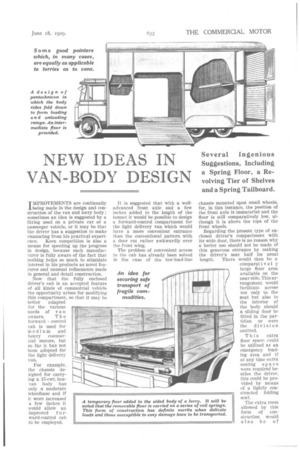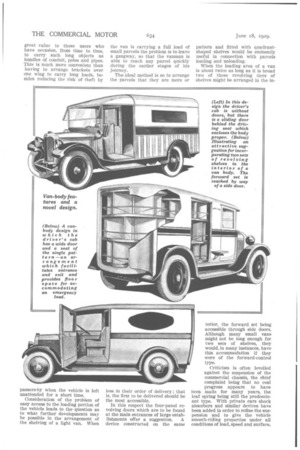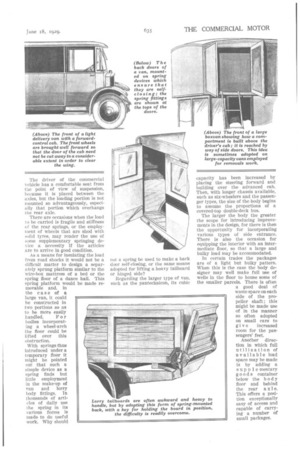NEW IDEAS IN VANODY DESIGN
Page 105

Page 106

Page 107

If you've noticed an error in this article please click here to report it so we can fix it.
I MPROVENIENTS are continually
being made in the design and construction of the van and lorry body ; sometimes an idea is suggested by a fitting used on a private car or a passenger vehicle, or it may be that the driver has a suggestion to make emanating from his practical experi
ence. Keen competition is also a means for speeding up the progress in design, because each manufacturer is fully aware of the fact that nothing helps so much to stimulate interest in his products as novel features and unusual refinements made in general and detail construction.
Now that the fully enclosed driver's cab is an accepted feature of all kinds of commercial vehicle the opportunity arises for modifying this compartment, so that it may he better adapted for the various needs of v a n owners. T h e forward control cab is used for medium and heavy conunercial motors, but so far it has not been adopted for the light delivery van.
For example, the chassis designed for carrying a 15-cwt. boxvan body has only a moderate wheelbase and if it were increased a few inches it would allow an
improved f o rward-control cab to be employed.
It is suggested that with a welladvanced front axle and a few inches added to the length of the bonnet it would be possible to design a forward-control compartment for the light delivery van which would have a more convenient entrance than the conventional pattern with a door cut rather awkwardly over the front wing.
The problem of convenient access to the cab has already been solved in the ease of the low-load-line chassis mounted upon small wheels, for, in this instance, the position of the front axle is immaterial and the floor is still comparatively low, although it is above the tops of the front wheels.
Regarding the present type of enclosed driver's compartment with its wide door, there is no reason why a better use should not be made of this generous entrance by making the driver's seat half its usual length. There would then be a comparat ivel y large floor area available on the near side. This arrangement would facilitate access not only to the seat hut also to the interior of the body should a sliding door be fitted in the partition or were the division omitted.
This extra floor space could be utilized as an emergency loading area and if at any time extra Seating space were required besides the driver, this could he provided by means of a lightly constructed folding seat.
The extra room allowed by this form of construction would also be of
great value to those users who have occasion, from time to time, to carry such long objects as bundles of conduit, poles and pipes. This is much more convenient than having to arrange brackets over one wing to carry long loads, besides reducing the risk of theft by passers-by when the vehicle Is left unattended for a short time.
Consideration of the problem of easy access to the loading portion of the vehicle leads to the question as to what further developments may be possible in the arrangement of the shelving of a light van. When the van is carrying a full load of small parcels the problem is to leave a gangway, so that the vanman is able to reach any parcel quickly during the earlier stages of his journey.
The ideal method is so to arrange the parcels that they are more or less in their order of delivery ; that is, the first to be delivered should be the most accessible.
In this respect the four-panel revolving doors which are to be found at the main entrances of large establishments offer a suggestion. A device constructed on the same pattern and fitted with quadrantshaped shelves would be eminently useful in connection with parcels loading and unloading.
When the loading area of a van is about twice as long as it is broad two of these revolving tiers of shelves might be arranged in the in tenor, the forward set being accessible through side doors. Although many small vans might not be long enough for two sets of shelves, they would, in many instances, have this accommodation if they were of the forward-control type.
Criticism is often levelled against the suspension of the commercial chassis, the chief complaint being that no real progress appears to have been made for many years, the leaf spring being still the predominant type. With private cars shock absorbers and similar devices have been added in order to refine the suspension and to give the vehicle smooth-riding properties under all conditions of load, speed and surface. The driver of the commercial vehicle has a comfortable seat from the point of view of suspension, because it is placed between the axles, but the loading portion is not mounted so advantageously, especially that portion which overhangs the rear axle.
There are occasions when the load to be carried is fragile and stiffness of the rear springs, or the employment of wheels that are shod with solid tyres, may render the use of some supplementary springing device a necessity if the articles are to arrive in good condition.
As a means for insulating the load from road shocks it would not be a difficult matter to design a separately sprung platform similar to the wire-box mattress of a bed or the spring floor of a dance hall. This spring platform would be made removable and, in the case of a large van, it could be constructed in two portions so as to be more easily
handled. F o r bodies incorporating a wheel-arch the floor could be lifted over this obstruction.
With springs thus Introduced under a temporary floor it might be pointed out that such a simple device as a spring finds but little employment in the make-up of van and lorry body fittings. In thousands of articles of daily use the spring in its various forms is made to do useful work. Why should
not a spring be used to make a back door self-closing, or the same means adopted for lifting a heavy tailboard or hinged side?
Regarding the larger type of van, such as the pantechnicon, its cubic capacity has been increased by placing the steering forward and building over the advanced cab. Then, with longer chassis available, such as six-wheelers and the passenger types, the size of the body begins to assume the proportions of a covered-top double-deck bus.
The larger the body the greater the scope for introducing improvements in the design, for there is then the opportunity for incorporating various types of side entrance. There is also the occasion for equipping the interior with an intermediate floor, so that a large and bulky load may be accommodated.
In certain trades the packages are of a light but bulky pattern. When this is the case the body designer may well make full use of wells in the floor to house some of the smaller parcels. There is often a good deal of waste space on each side of the propeller shaft ; this might be made use of in the manner so often adopted on small cars to give increased room for the passengers' feet.
Another direction in which full utilization of available load space may be made is by adding a supple mentary goods container below the body floor and behind the rear axle. This offers a position exceptionally easy of access and capable of carrying a number of small packages.








































































































































































































